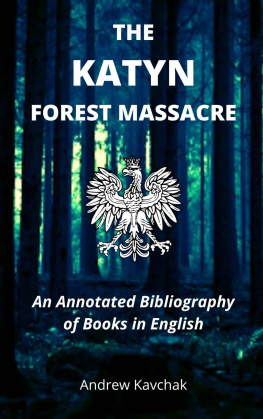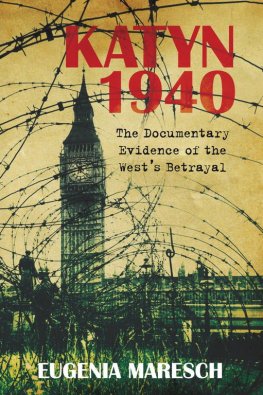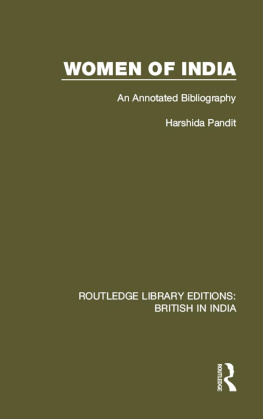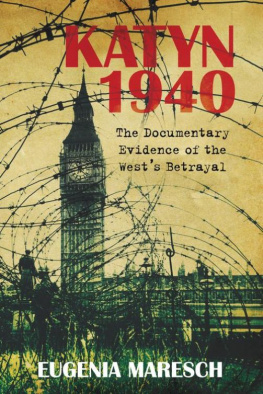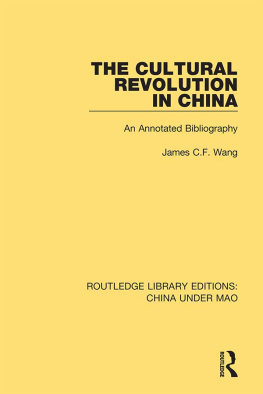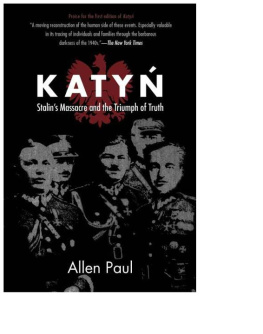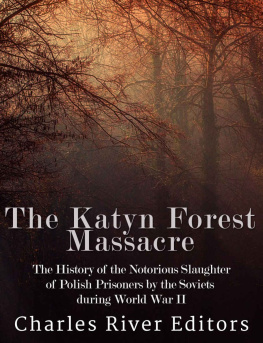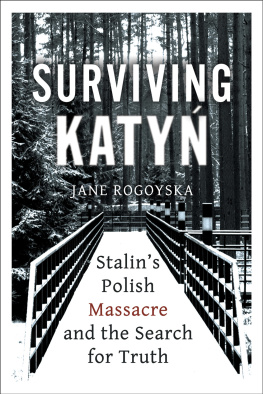Andrew Kavchak - The Katyn Forest Massacre: An Annotated Bibliography of Books in English
Here you can read online Andrew Kavchak - The Katyn Forest Massacre: An Annotated Bibliography of Books in English full text of the book (entire story) in english for free. Download pdf and epub, get meaning, cover and reviews about this ebook. year: 2020, genre: Politics. Description of the work, (preface) as well as reviews are available. Best literature library LitArk.com created for fans of good reading and offers a wide selection of genres:
Romance novel
Science fiction
Adventure
Detective
Science
History
Home and family
Prose
Art
Politics
Computer
Non-fiction
Religion
Business
Children
Humor
Choose a favorite category and find really read worthwhile books. Enjoy immersion in the world of imagination, feel the emotions of the characters or learn something new for yourself, make an fascinating discovery.
- Book:The Katyn Forest Massacre: An Annotated Bibliography of Books in English
- Author:
- Genre:
- Year:2020
- Rating:5 / 5
- Favourites:Add to favourites
- Your mark:
- 100
- 1
- 2
- 3
- 4
- 5
The Katyn Forest Massacre: An Annotated Bibliography of Books in English: summary, description and annotation
We offer to read an annotation, description, summary or preface (depends on what the author of the book "The Katyn Forest Massacre: An Annotated Bibliography of Books in English" wrote himself). If you haven't found the necessary information about the book — write in the comments, we will try to find it.
Andrew Kavchak: author's other books
Who wrote The Katyn Forest Massacre: An Annotated Bibliography of Books in English? Find out the surname, the name of the author of the book and a list of all author's works by series.
The Katyn Forest Massacre: An Annotated Bibliography of Books in English — read online for free the complete book (whole text) full work
Below is the text of the book, divided by pages. System saving the place of the last page read, allows you to conveniently read the book "The Katyn Forest Massacre: An Annotated Bibliography of Books in English" online for free, without having to search again every time where you left off. Put a bookmark, and you can go to the page where you finished reading at any time.
Font size:
Interval:
Bookmark:
The katyn forest massacre
An Annotated Bibliography of Books in English
Andrew Kavchak
Copyright 2020 Andrew Kavchak
All Rights Reserved.
Independently published.
Ebooks and paperbacks available from Amazons website.
To all 21,857 victims of the Katyn Massacre,
including my grandfather Stanisaw Kawczak.

CONTENTS
Foreword by
Dr. Alexander M. Jablonski
I am honoured to write a foreword to a very special work titled The Katyn Forest Massacre: An Annotated Bibliography of Books in English by Andrew Kavchak of Ottawa. His book is dedicated to his grandfather, Captain Stanisaw Kawczak, a Polish lawyer and officer, and to all his Polish colleagues murdered by the NKVD in the Katyn Forest Massacre. My great-uncle from my maternal side, Major Wadysaw Julian Siemek, a Polish officer, military cartographer and topographer, was also killed in this Massacre. He was the beloved younger brother of five sisters, one of them being my grandmother Olga. He was called Uncle Wadek by everybody including my late mother. I have heard about Katyn since my early childhood and I share deep feelings about it with the author.
There are thousands of books, articles and notes on the Katyn Forest Massacre, in Polish, and much, much less in other languages including English. This annotated bibliography presents a selected cross-section of very important accounts of the Katyn Forest Massacre from various perspectives in a skillful manner. In a twist of fate, the Katyn Forest witnessed another tragedy, when on April 10, 2010, a presidential plane crash near Smolensk, Russia, claimed the lives of the President of Poland, Professor Lech Kaczyski, his wife Maria, the last Polish President in-Exile in London, Ryszard Kaczorowski, and 93 other passengers as well as the whole crew. The delegation of high-ranking officials included also some family members of the victims of Katyn. They were supposed to pay a tribute to the victims on the 70 th Anniversary of the Katyn Forest Massacre. The world once again was informed about Katyn in addition to this tragic news. Thus, there is now a renewed interest in studying Katyn and all of its historical, sociological and even psychological aspects.
The term Katyn Forest Massacre is used to encompass an unspeakable murder of 21,857 interned Polish Army Officers, policemen, military settlers, landowners, government officials and members of the Polish intelligentsia in April and May 1940 by the Soviets. The term is also used in Polish history to refer to the Soviet extermination of Polish intelligentsia in the Eastern half of Poland that the Soviets annexed in 1939. The Soviet annexation of Eastern Poland was made possible by the Molotov-Ribbentrop Pact signed on August 23, 1939 in Moscow between Nazi Germany and Soviet Russia. This pact was the main signal to start WWII, which claimed between 50 and 80 million of lives (including those brutally murdered by both signatories).
In addition to the statement of non-aggression between each other, the treaty included a secret protocol, which was not known for a long time and divided Central and Eastern Europe into two zones of influence Soviet and Nazi German zones. It divided the territories of Poland, Romania, Lithuania, Latvia, Estonia and Finland, established by the Treaty of Versailles in 1919 after WWI.
As an immediate result of the Molotov-Ribbentrop Pact, and earlier war plans, Nazi Germany invaded Poland from three directions (west, north and south) on September 1, 1939. After the Soviet-Japanese ceasefire, which started on September 16, 1939, the Soviet Union invaded Poland (along the entire border from the east) on September 17, 1939. On November 30, the same year, Soviet troops attacked Finland along its entire eastern border starting the bloody Winter War of 1939-1940.
Circumstances surrounding the Soviet decision to kill more than 21 thousand Polish POWs and prisoners taken after the invasion, which constituted the Polish national elite, the leading circles of the Polish intelligentsia, and also the commanding cadre of the Polish Army, of the highest fighting and organizational potential are not fully known to the present day. However, it is known that Nazi Germany and Soviet Russia shared their plans of extermination of the leading Polish circles of intelligentsia during several secret meetings. Currently, after eighty years since the Katyn Forest Massacre, there are attempts in Russia to deny the importance of the Molotov-Ribbentrop Pact, and that it was planned and fully executed by both dictatorial powers.
On April 13, 1990, Gorbachevs Soviet Russia finally provided two sets of documents to Poland, which included the transport lists of names of executed Polish Officers and prisoners during the Katyn Forest Massacre from the three concentration camps of Kozelsk, Starobelsk and Ostashkov. However, these lists did not include all victims. On the same date, the Russian Press Agency, TASS, released these materials with a statement that attributed this mass murder as the prime responsibility of Beria, Merkulov and their supporters. The Soviet side expressed their regrets for the occurrence of the massacre and admitted, for the first time in fifty years, that it represents one of the gravest crimes of Stalinism.
The note of Beria to the Politburo of the Soviet Communist Party of early March 1940 is among the most important irrefutable evidence of Soviet guilt in the Katyn related series of mass murders. This note refers to a total of 25,421 Polish citizens to be executed. However, a subsequent KGB memorandum confirmed that there were 21,857 victims during the Katyn Forest Massacre. The numbers of POWs held in the three camps for liquidation varied, but on April 1, 1940, there were 4,599 POWs in Kozelsk, 3,894 in Starobelsk and 6,364 in Ostashkov. The remaining prisoners were murdered in the Soviet prisons in the Western Ukraine and Belorussia. The Soviet authorities provided the Polish side all transport lists for execution from these three camps. In addition, the Katyn Massacre included so-called Katyn mass murders in Kiev and in Minsk ( Encyklopedia Biaych Plam, POLWEN Polskie Wydawnictwo Encyklopedyczne, Radom 2002; [encyclopedia White Spots]).
This unprecedented crime in the history of modern warfare was committed pursuant to Stalins and his Politburos execution order. Almost 1/3 of Polands brilliant Officer Corps of a very well trained and patriotic army perished along with most of the government elite from Eastern Poland, and a large Polish territory was forcibly annexed by the Soviet Union. Some tend to think that this crime must have been to avenge the Bolshevik loss in the Polish-Russian War of 1919-1920, when the newly resurrected Poland defeated them 100 hundred years ago in a number of battles including a magnificent victory in the Battle of Warsaw (called by some the 18 th most important battle in the human history).
Andrzej Przewonik, who was Secretary of the Council for the Protection of Struggle and Martyrdom Sites (Rada Ochrony Pamici Walk i Mczestwa), was killed during the presidential plane crash in Smolensk on April 10, 2010. His main accomplishment before this tragedy was the establishment of the Polish Military Cemeteries in Katyn and Mednoye in the Russian Federation, and in Kharkov in Ukraine. Before the crash Andrzej Przewonik wrote the book titled Zbrodnia Katyska MordKamstwoPami (The Katyn Massacre MurderLieRemembrance) , but he could not complete it. This was done by Jolanta Adamska together with Andrzejs wife in 2011. (Andrzej Przewonik, Jolanta Adamska, Zbrodnia katyska Mord-Kamstwo-Pami. Krakw: Wydawnictwo Literackie, 2011).
The subtitle of his book is very important. The Katyn Forest Massacre lie was a cornerstone of the Communist system in Poland between 1944 and 1989. It was impossible to talk openly about it. The official version of history in Communist Poland was based on the official Soviet falsification of historical facts which was that it was the Germans who killed the Polish officers. Many people were prosecuted because they wanted to challenge this lie. The lie was also supported and assisted by manipulation from other sources. The manipulation of the Polish history served not only the Russians, but also the Western Allies. They quickly forgot about the Polish struggle during WWII and the substantial participation of the Polish Armed Forces in the victory efforts. The information about the Katyn Forest Massacre was subject to manipulation and supposed to be forgotten, as the price for Russian participation in the victory over Nazi Germany and other Axis forces. It remains politically incorrect to talk about the genocidal measures of the Eastern Ally. Katyn remains unknown territory to many, including those in Canada and the United States. There is no account about it in history courses in high schools, and it is inexplicably ignored in university level courses.
Font size:
Interval:
Bookmark:
Similar books «The Katyn Forest Massacre: An Annotated Bibliography of Books in English»
Look at similar books to The Katyn Forest Massacre: An Annotated Bibliography of Books in English. We have selected literature similar in name and meaning in the hope of providing readers with more options to find new, interesting, not yet read works.
Discussion, reviews of the book The Katyn Forest Massacre: An Annotated Bibliography of Books in English and just readers' own opinions. Leave your comments, write what you think about the work, its meaning or the main characters. Specify what exactly you liked and what you didn't like, and why you think so.

